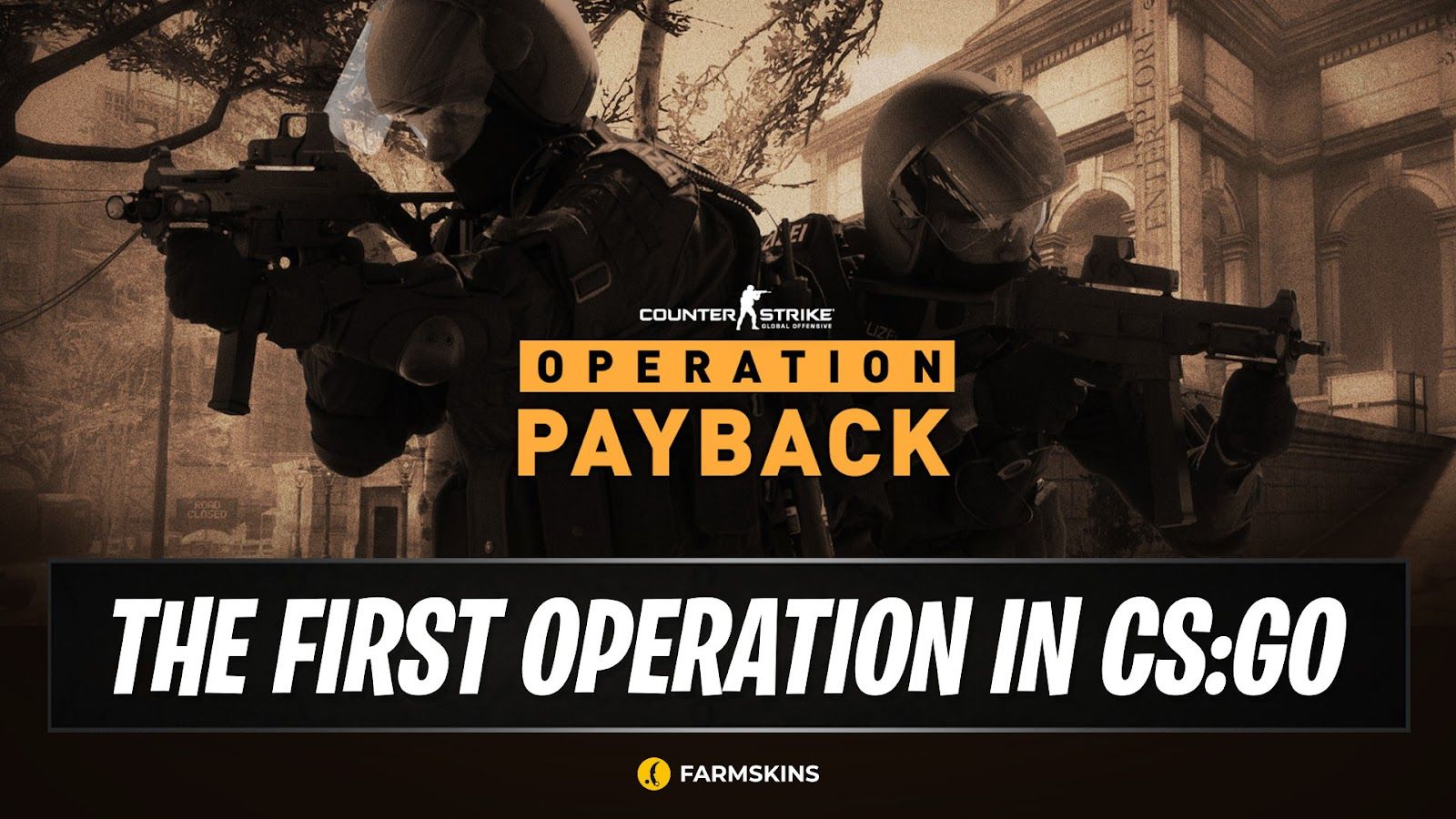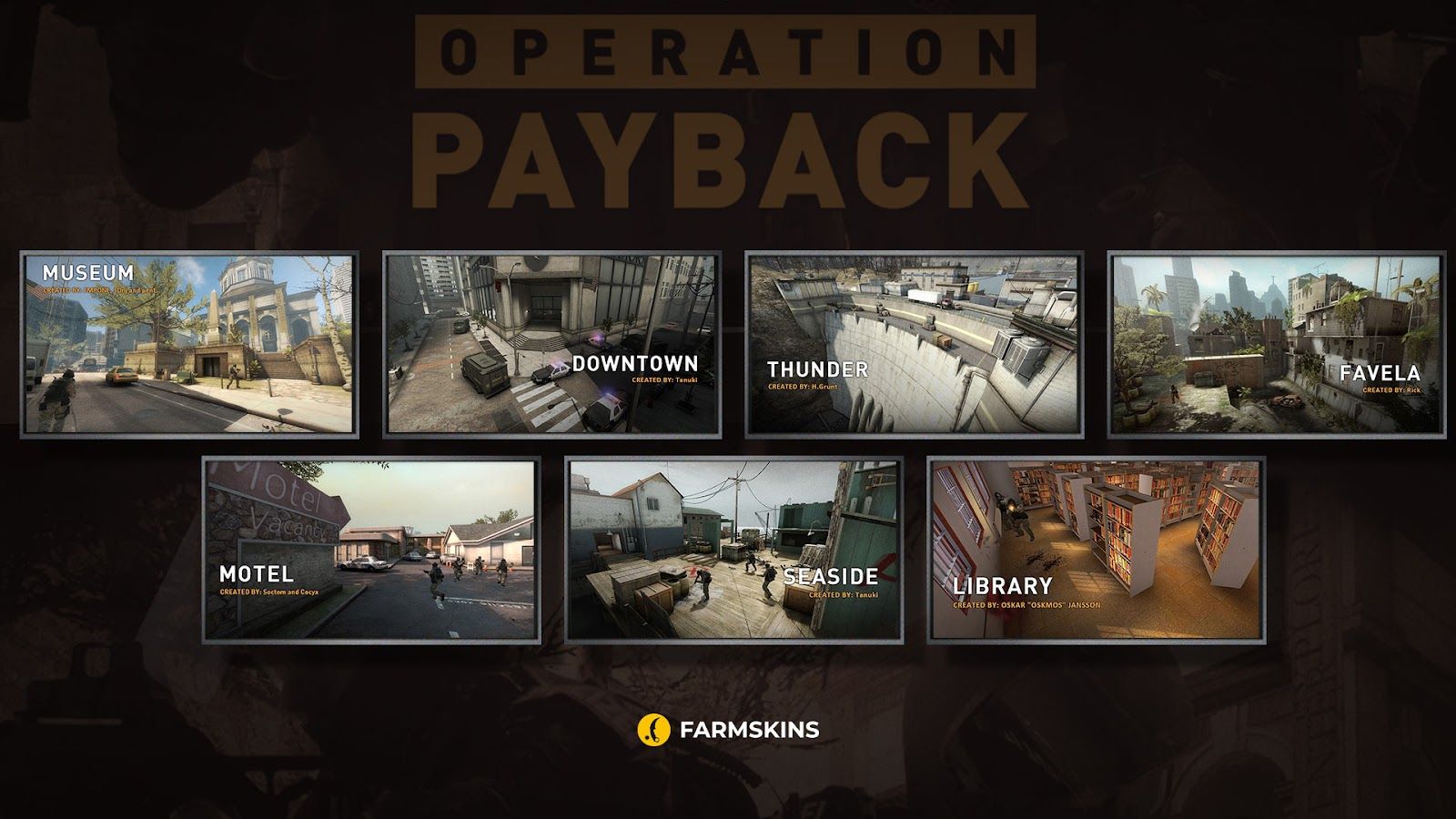The First operation in CS:GO: Operation “Payback”

Operation Payback was released as the first operation for CS:GO back in April 2013 when the game was just exploding in popularity. From this event, it will become critical not only for Valve but also for players because such mechanisms were introduced when users could actively participate in the development of games. The operation was to add more community-made maps to the gaming system; it also implemented a reward system, which worked for attracting a broad audience.
At the time CS:GO was released in 2012, the community was hungry for diversification to the gameplay updates. Where their predecessors were heavily buoyed by the framework of modders and the community, this new game was more structured and as such didn't accommodate these features. Operation Payback in CS:GO took the first step to change that by providing specific community created content & a new reward system for actively participating in gameplay.
The Development of Operation Concepts: How Payback Shaped the Future
Before Operation Payback, maps for CS:GO were exclusively created by Valve, and players had no direct influence on the selection of maps for official gameplay modes. However, with the release of Payback, the door was opened for community-created maps to be included in official game modes, marking the beginning of a new era in CS:GO's development. The community became the driving force behind the game's evolution, offering new and exciting map solutions.
At the time of its release, the operation included seven community-created maps, a significant step toward integrating user-generated content into the game. Valve began actively supporting map creators by giving them the opportunity to earn money from their creations through in-game purchases. This encouraged community participation, leading to the development of more high-quality maps in the future.

Coin and Progression System: Innovations in Payback
A central element of Operation Payback was the coin system, which was awarded to players for participating in the operation and completing specific tasks on the newly introduced maps. The CS:GO operation coin had three levels: bronze, silver, and gold. To upgrade their coin, players needed to spend a certain amount of time playing on the operation maps. The bronze coin was awarded immediately after purchasing the pass, the silver after 10 hours of gameplay, and the gold coin required 50 hours.
This system encouraged players to spend more time in the game and explore new maps, fostering increased interest. Each achievement felt like a reward for the effort, and obtaining the gold coin became a prestigious accomplishment for many in the community. The coins earned during the operation remained in the player's inventory permanently, making them desirable trophies for collectors.
The Payback Pass: From Simple Purchase to Rare Collectible
A crucial part of Operation Payback was the pass, which had to be purchased to gain access to the special maps and reward system. At the time of the operation’s release, the pass cost approximately $5.99, making it accessible to most players. The pass unlocked exclusive maps, allowed players to earn rewards, and progress through the coin system.
Initially, the pass didn't cause much excitement since no one knew how successful this format would be in the future. After all, when the operation concluded and CS:GO kept growing in popularity, it turned into something rare and truly valuable as a pass for collectors. Nowadays, its price on the Steam marketplace can rise up to $450, which is 75 times more than its initial cost — making the pass one of the most expensive, rare items in the game (though it does not grant access to the operation, to be clear).
Payback Maps: Unique Locations and Innovative Designs

The maps introduced during Operation Payback were a key part of its success. The community of map creators worked actively to develop unique locations, each with its own atmosphere and style. These Payback maps were diverse in design and gameplay features, offering players fresh and exciting experiences.
-
Museum – One of the most impressive maps created for the operation, set in a fictional museum displaying various paleontological exhibits, including giant dinosaur skeletons. The map was praised for its detail and unique setting, which stood out from typical CS
maps. Players navigated through museum exhibits, adding a layer of tactical variety to the gameplay. -
Favela – A map inspired by the favelas of Rio de Janeiro. This location was meticulously crafted with attention to detail, from scattered trash containers to multi-level houses perched on hillsides. Favela became one of the most popular maps in the operation due to its dynamic nature and visual style, immersing players in the atmosphere of Brazilian slums.
-
Library – A map where players fought among bookshelves. The compact and intricate structure of this location resembled a labyrinth. Randomly placed objects throughout the map allowed players to utilize numerous hiding spots and tactical opportunities during combat.
-
Motel – A map with the atmosphere of a classic American motel, where players fought within the grounds of an abandoned building. Old cars and police vehicles scattered around added a special charm to the map. Motel featured many strategic points, such as balconies and narrow corridors, making the gameplay particularly tense and tactical.
-
Thunder – A map based on the classic Nuke, but set in a hydroelectric power station. It offered breathtaking scenery and complex routes, making it popular with both newcomers and veterans of the game. Thunder became a cult favorite for many players due to its roots in the CS 1.6 era.
The Impact of Payback on the Development of User-Generated Content
Operation Payback was a major milestone in the development of user-generated content in CS:GO. Valve introduced a system that allowed map creators to earn money through pass purchases. This incentivized talented modders to create high-quality maps, which could be included in official game operations.
As a result of this operation, the map creators involved earned over $150,000, which was a significant amount at the time. This led to the growth of user-generated content in CS:GO, with many talented developers beginning to actively work on new maps and modifications for the game. Valve realized that supporting the community could be profitable for both developers and the game itself, and this model became the foundation for future operations.
Top 5 best Community maps in CS2
The Legacy of Payback and Its Significance for CS
Operation Payback had a tremendous impact on the future of CS:GO. It demonstrated that the community could play a key role in the game's development, and community-made maps could become an important part of the gameplay experience. Valve continued to release operations, each bringing new maps, challenges, and gameplay elements.
Payback in CS:GO marked the beginning of a new era in CS:GO, laying the groundwork for all subsequent operations. It showed that the game could constantly evolve and offer something new, attracting players and creating new opportunities for creativity within the community.











